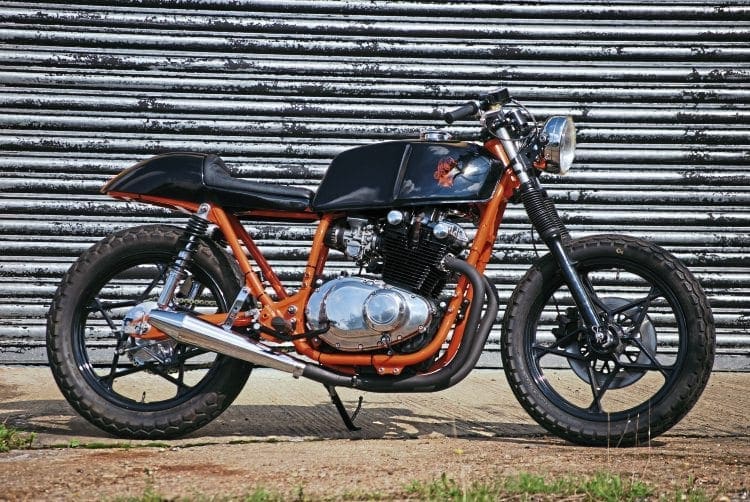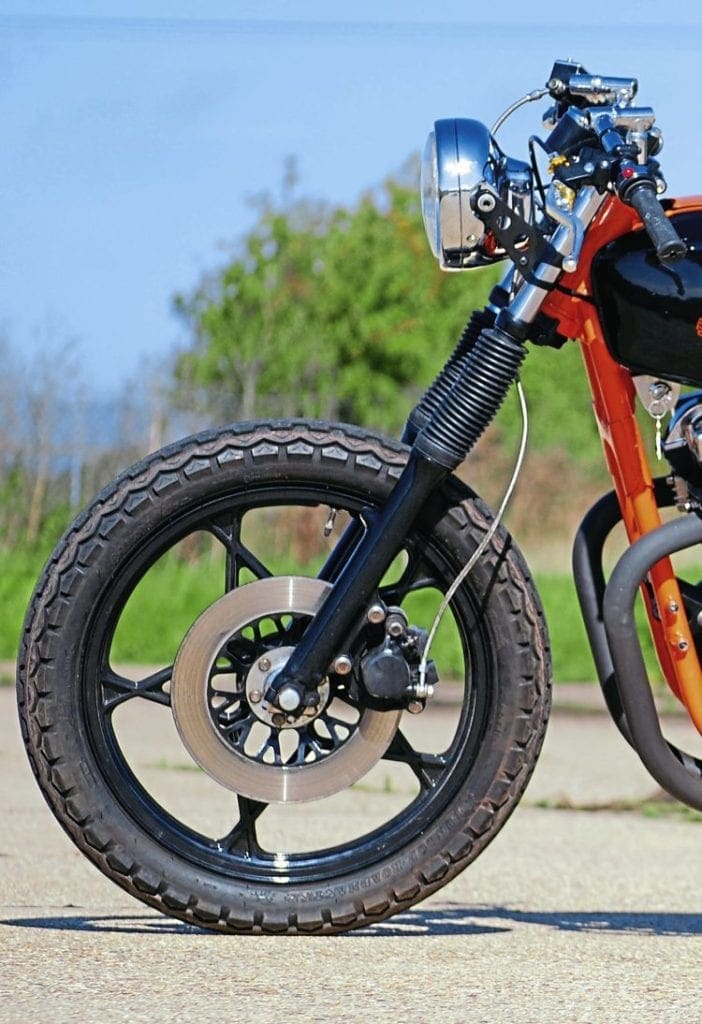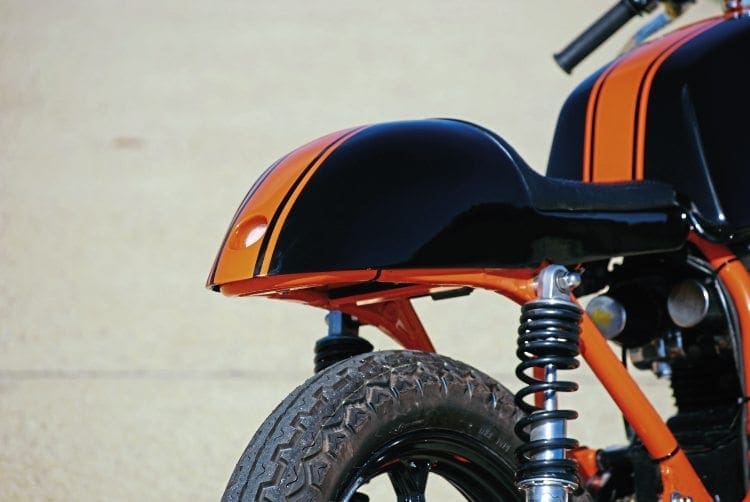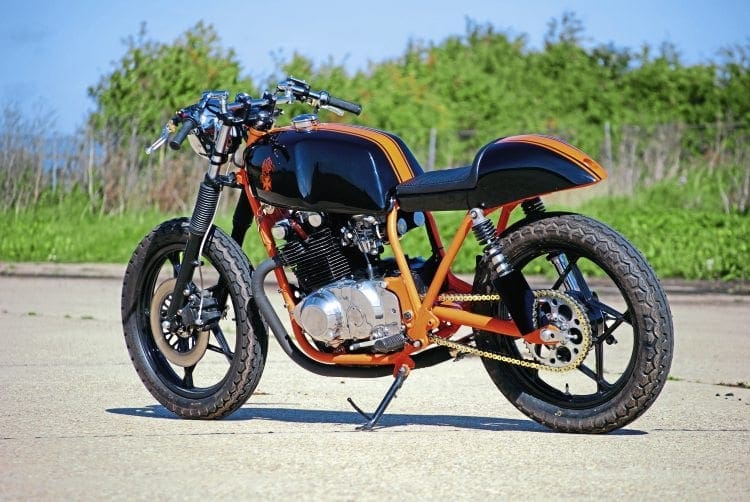Effort and expertise transform a ‘so what’ 1980s streetbike into a ‘so wow!’ café custom
WORDS & PHOTOS by Carl Bennett
BARELY NOTICED BY anyone, Suzuki’s unassuming air-cooled GS450 parallel twin quietly served thousands of commuters across the globe for an entire decade in the 1980s.
Its GS500 replacement inconspicuously continued for another 15 years. Both owe their existence to their predecessors, the GS400 and GS425 of the late 1970s, although the 450/500 are considerably refined compared to their earlier counterparts and few engine components transfer between the two series.
The dohc GS450, with its single-piece, 180-degree crank and two valves per cylinder, was light and lively.
Its pistons were fatter and shorter than those of the earlier 425 so it revved more rapidly to its maximum of 42bhp at 9000rpm (later versions gained an additional two horses and pushed the revs 500rpm higher).

The 450 didn’t offer any more torque than the 425, however, all the extra excitement came at the top end.
The six-speed gearbox meant peppy performance was accessible at all speeds if the rider was prepared to keep shifting cogs, aided by a digital gear indicator in case counting to six turned out to be too tricky.
By then, Japanese engineering had conquered camchain concerns; the GS450 uses a simplex, self-adjusting chain.
Likewise, untoward parallel twin vibration was subdued by a gear-driven counter-balancer. Transistorised electronic ignition, a three-phase alternator and electric starting brought the GS series into the modern world, and Suzuki even had the confidence to jettison the kickstart lever which adorned the 425.

If the engine was surprisingly sophisticated for its time and market niche, the chassis was reassuringly uncomplicated and conventional.
In this instance there was no need to fix what wasn’t broken, so the twin downtube steel cradle frame featured unremarkable suspension, a single disc up front and a drum brake at the back.
If anything, the engine always out-performed the softly sprung chassis, but that rarely mattered as the GS450 was seldom pressed into service as a sportsbike.
It went willingly to work, trounced Yamaha’s XS, held its own against Honda’s CB and couldn’t be caught by a Kawasaki twin until the GPZ500S came along.

In the UK, most GS450s were Eurostyle E models, although Americans preferred the ST with its handlebar fairing, or the L cruiser. There was even a Suzukimatic ‘A’ version which changed its own gears.
Given the limitations of its chassis and the perky potential of its engine, a GS450 certainly looks like a good basis for a project today if you can find one which hasn’t been wildly mistreated.
When discovered, this 1981 bike had the stock high bars, a modest king and queen seat and factory exhausts that looked just a bit like slightly more civilised Dunstall megaphones.
Just when most bikes are about to languish at the bottom of a garden under a plastic tarpaulin prior to the last trip to the crusher, still doggedly useable but not exactly in showroom condition, this one fell into the hands of So Low Choppers. It was never quite the same again.

So Low is an unapologetic chopper shop. Clive Ransome founded the business because he and his son like old-skool chops.
So this build was obviously different to So Low’s normal brief. The object was to show that, while choppers were and are the chrome-plated blood flowing through So Low’s veins, the crew there aren’t one-trick iron ponies.
The business builds anything, from streetfighters to mild customs, brats or rats – whatever the customer wants. Because they can. As Clive says: “What better way to show we don’t just do choppers than to build the complete opposite?”
The Suzuki’s frame was heavily hacked to keep the weight down and to accept a new custom fibreglass rear seat pan.

That hid all the ugly but necessary electrics and gave the LED rear light somewhere nice to live. Once all the cutting and refurbishing had been done it was time to powdercoat, polish and paint the frame all over.
GB Upholstery then layered the seat tray with a highly unusual basket weave.
To keep the retro vibe, the original wheels were refurbished with a high-gloss powdercoat and TT100s fitted to keep things sticky.
The whole ethos was retro-but-rideable, so Laverda Jota-style adjustable bars were slipped on, and proved surprisingly comfortable paired with new adjustable levers. Up front everything looks simple, clean and functional, from the new master cylinder to the Wipac switchgear replacing the original kit.

An MMB mini-speedo keeps it all legal while a 7” headlight and rubber fork gaiters provide real blast-from-the-past café-racer looks.
This brings us to the exhaust, which was changed from the original specification, not wildly so, but for practical purposes like the rest of the bike.
So Low made a traditional-looking two-into-one set-up, then stuck a reverse megaphone on the end. The exhaust was given a black ceramic finish for durability while the not-really-a-silencer was left in chrome for a bit of understated sparkly contrast.
It sounds even better than it looks, says Clive. “It’s the most noticeable improvement. Not too loud, but noisy enough to put a grin on your face.”
Inevitably, the 25-year-old rear shocks were fit for the bin and new ones were installed, along with every bearing in the rolling chassis.
This level of attention to detail takes time, and according to Clive the whole project took way longer than it should have done.

The Suzuki turned into a labour of something close to love, and without a customer-driven deadline the work could be completed when there was the time to get it just right.
While the original GS frame was never notoriously horrible, on the So Low Suzuki it’s officially great with a capital GR according to Clive’s son Jay.
The secret is the considerably lower centre of gravity, the result of weight shaved off in the conversion and the more aggressive riding position.
Above all, the GS is reliable, not the sort of custom classic that spends a sunny day out and a week back in the service bay.
The result is a rideable bike with traditional appeal; a modern classic café racer that doesn’t need a drip tray under the sidestand.
Not only are the looks radically less stodgy than the donor bike’s, the ride is a lot different.
The facility to set-up the hand-controls to fit the rider means “the riding position is more comfortable, making you feel like you’re going fast when you’re stationary,” according to Clive. “It glides around corners with the TT100s sticking you to the road like glue.”
PRICE GUIDE
£250 to £700
for standard donor GS450
FAULTS & FOIBLES
Refreshingly few; clean the carbs, replace the diaphragms, check the shims (an easy job) and ride away. The sidestand clutch cut-out can fail; just bypass the switch
ALSO CONSIDER
Honda CB350S (loses out on performance with only 34bhp). Honda 400N Superdream (if you have trouble sleeping at night). Kawasaki Z440 (almost nothing to recommend it apart from price, and even then…) Yamaha RD350 (now you’re talking! But it is a two-stroke)
SPECIALIST INFO
solowchoppers.co.uk
suzukicycles.org
crooks-suzuki.com
OWNERS’ CLUB
Vintage Japanese:
vjmc.com

MANUFACTURED: 1980 to 1991 ENGINE: Air-cooled dohc parallel twin BORE / STROKE: 71mm x 56.6mm CAPACITY: 448cc COMPRESSION: 9:1 POWER: 42bhp @ 9000rpm (later 44bhp @ 9500) TORQUE: 36Nm @ 7500rpm CARBURETION: 2x 34mm CV Mikuni CLUTCH: Multiplate, wet GEARBOX: 6 speed FRONT SUSPENSION: 33mm tele forks, air assisted REAR SUSPENSION: Swinging arm, twin shocks, preload adjustable FRONT BRAKE: Single 270mm disc REAR BRAKE: sls drum FRONT TYRE: 3.00 x 18 REAR TYRE: 3.50 x 18 WEIGHT: 175kg dry FUEL CONSUMPTION: 55mpg ACCELERATION: 13.9s quarter mile BRAKING: 32ft from 30mph TOP SPEED: 102mph


